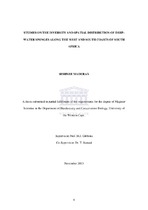| dc.contributor.advisor | Gibbons, M.J. | |
| dc.contributor.advisor | Samaai, Toufiek | |
| dc.contributor.author | Maduray, Seshnee | |
| dc.date.accessioned | 2016-07-19T09:14:02Z | |
| dc.date.available | 2016-07-19T09:14:02Z | |
| dc.date.issued | 2013 | |
| dc.identifier.uri | http://hdl.handle.net/11394/5132 | |
| dc.description | Magister Scientiae (Biodiversity and Conservation Biology) - MSc (Biodiv and Cons Biol) | en_US |
| dc.description.abstract | This thesis explores the diversity, spatial patterns and community structure for the sponges (Porifera) along the west and south coasts of South Africa. Species collected were identified to the lowest level of lowest taxonomic unit possible (either species or genus). The study site was divided into areas and in each of these we documented the spatial diversity and in so doing were able to assess the variation of sponge communities between the west and south coasts. The total number of species recorded for this deep-water region was eighty-three of which nineteen are described. The south coast was more diverse than the west coast and eleven species were found to be common to both coasts. The analysis based on location and depth showed that both coasts are significantly different to each other. We determined that these areas are biogeographically separated. Species contributing toward the dissimilarity between both coasts include Suberites carnosus, Myxilla (Burtonanchora) sp 1, Rossella antarctica, Tetilla capillosa and Haliclona sp. Patterns of species richness showed an increase in diversity from the west to south. It was found that species richness increases with depth for both coasts but only up to 350 m for the west coast and 200 m for the south coast. However, the sampling effort was determined to possibly have not been enough to gain a full understanding of species richness for the entire study area as the number of species was correlated with sampling effort. Estimated richness found that higher richness of sponges could still be found within most of the best bins and for each coast. An estimate of samples needed both each depth bin per coast showed that more samples would be needed on the south coast and this is possibly due to the greater variety and variability of the species found on the coast. The sponge community on the south coast was found to have no significant
difference in pattern with some of the depth bins, whereas depth plays a role in
sponge community on the west coast. Species of Suberites were dominant at
depths lower than 200 m while Hamacantha (Vomerula) esperioides was dominant between 200 and 350 m with Tetilla capillosa dominated depths lower than 350 m. The thesis is concluded with an overview of what is now known and what still needs to be discovered and determined to further enhance biodiversity knowledge in the country. | en_US |
| dc.language.iso | en | en_US |
| dc.publisher | University of the Western Cape | en_US |
| dc.subject | Sponges | en_US |
| dc.subject | Deep-water | en_US |
| dc.subject | Taxonomy | en_US |
| dc.subject | Biogeography | en_US |
| dc.subject | South Africa | en_US |
| dc.title | Studies on the diversity and spatial distribution of deep-water sponges along the west and south coasts of South Africa | en_US |
| dc.type | Thesis | en_US |
| dc.rights.holder | University of the Western Cape | en_US |

